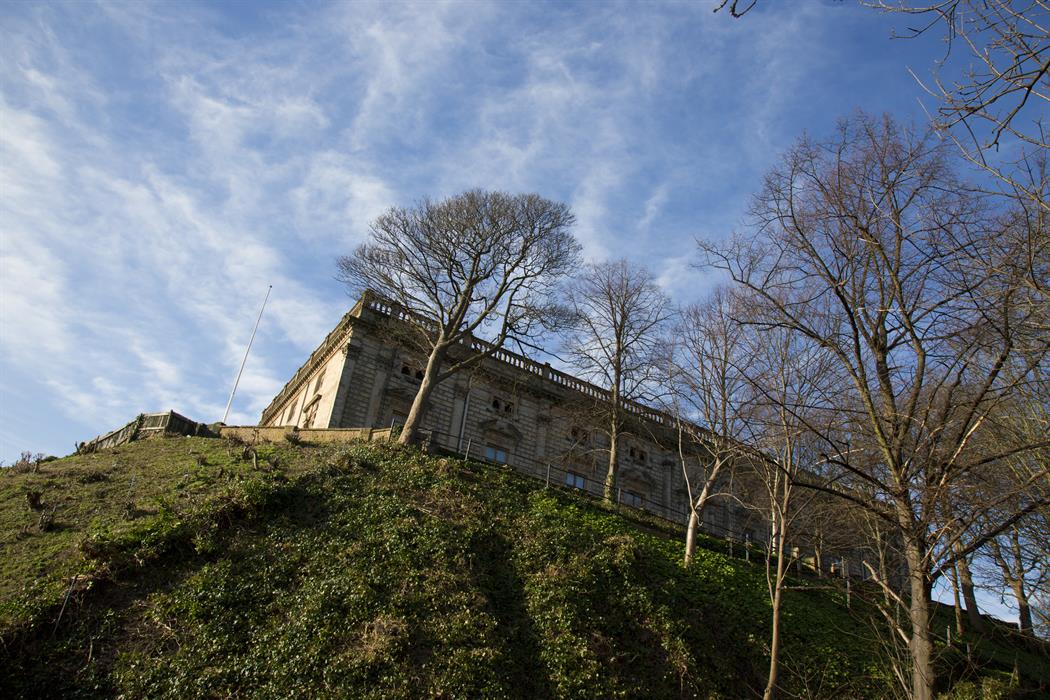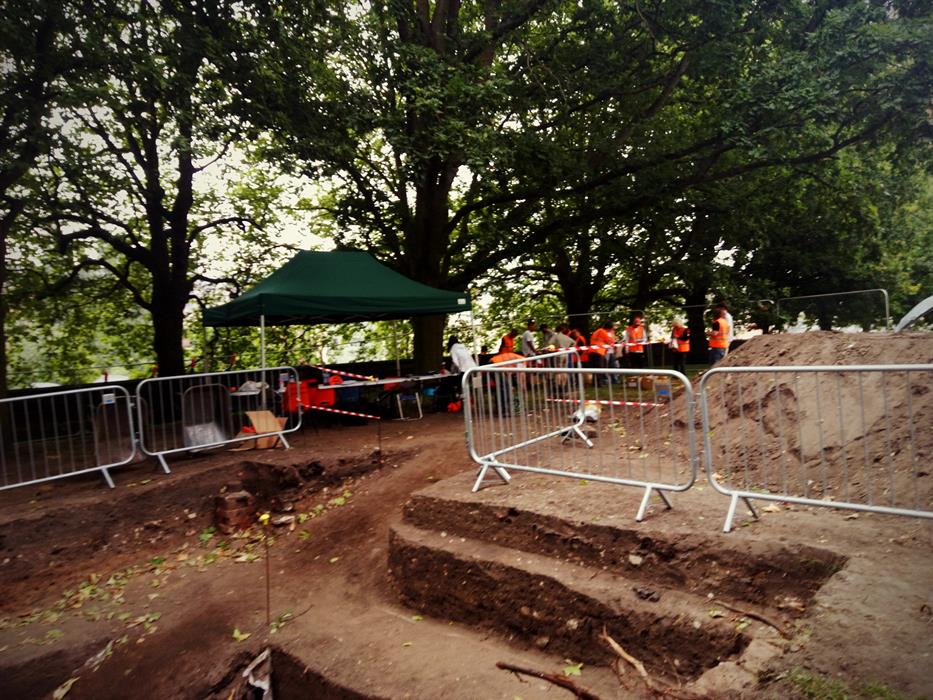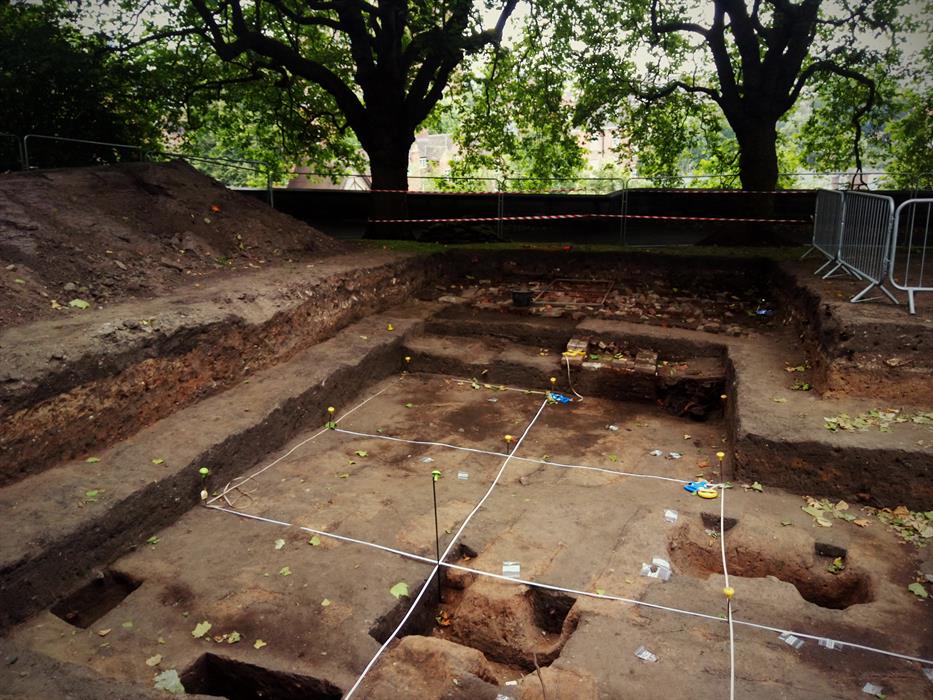Please note: this blog is part one of two. Click here for the next installment.
For centuries, there has existed a castle on that craggy hill overlooking Nottingham. Throughout the past 1,000 years, different structures have come and gone, from robust medieval forts with familiar motte-and-bailey designs, to the smart ducal palace we know today, each reflecting their times and telling a dramatic story of its own.
We are quite familiar with the astonishing network of caves beneath our city, but what of the more subtle secrets that lie beneath the earth? To discover more about Nottingham’s forgotten history, each year Trent Peak & Archaeology excavate an area of Nottingham Castle grounds to add some missing pieces to the story of the castle. Through their finds clues are uncovered that shed light on the different periods of life upon castle rock.

First held in 2015, We Dig The Castle runs every summer as a partnership between Nottingham City Council, Trent & Peak Archaeology and Historic England. Inviting regular members of the public to train as archaeologists, over TPA's five week residency at the Castle they invite trainees to help with the dig. Over a chosen period, lasting between one day and several weeks, trainees are able to learn about archaeology, identifying finds, and the aftercare such as cleaning the treasures. ‘While we do have research questions and objectives, the priority is the trainees; learning archaeology and expanding their skills.’ Said Alison of TPA.
While you might think that the history around the castle is bound to have been well-preserved, there are still many facts that are unresolved or unknown. It is true the estate was once far bigger, extending up Standard Hill and into to the sprawling Park estate below, but where the defences of this northern territory lay has never been noted, and perhaps is lost to history due to the city development.
But in many cases, the most comprehensive route to truth is embedded within the ground. ‘I think people are sometimes disappointed that there is no medieval castle here, thinking there’s no story and nothing of interest,’ Alison commented ‘But it’s been a really important part of the life of the people of Nottingham and has changed over time, and we’re just uncovering that relationship now.”
Indeed, this most regal city site has not always been restricted to the nobility. During the Victorian era, in keeping with the rebellious spirit of Nottingham folk, rioters raised The Castle to the ground in outrage of the Reform Acts, leaving the castle to lay derelict for 47 years. TPA have identified that throughout this period gardens and allotments were placed around the site, presumably owned by regular citizens, with one of the recent finds being the walls and foundations of a greenhouse.
‘We suspect there was a couple of phases to the garden allotments, and think there was a period of abandonment where they were not used at all. During that period we found a badger set which contained a dog skeleton. So perhaps someone was badger baiting and set the dog into the set, only the dog didn’t make it back out.’
It is below this level however where things get interesting. At present the excavation site is around 1.5 meters deep, but over the next four weeks it is likely to delve further down revealing pre-Victorian era land.
‘So much of archaeology is interpretation, and often conjecture and guesswork.’ Alison tells us. ‘So what they find in the lower level might cause them to modify or even change how they’ve understood the upper levels.’

In previous years TPA have uncovered some pretty interesting finds. One favourite is a piece of German Westerwald pottery, thought to be owned by the First Duke of Newcastle in the 17th century. TPA’s Matt explains how they came to this conclusion: “The Duke who built the palace really loved it, however his descendants weren’t too keen. So it’s more likely that high quality finds relate to him rather than subsequent members who probably never lived on site.”
Pottery is the most commonly found, but what are they most excited about finding? ‘Cannonballs.’ Says Matt. ‘The site is located opposite St Nicholas’ Church. The royalists decided during the civil war that it would be a grand idea to set a cannon up on top of it and fire into the castle from there. Colonel Hutchinson the Puritan leader who was looking after the parliamentarian garrison here set a cannon up here in the castle ground too and flattened the church, so it would be lovely to find cannonballs.’

The trainees are able to book 1-2 day taster sessions, or spend up to 5 weeks on site for a really in-depth experience. ‘For us this one is of the most rewarding projects that we do,’ Alison explains. ‘You see people come along, low on confidence, within a group of strangers, and by the end of the week their confidence has blossomed, they feel like archaeologists, they’ve found something and can tell people that they’re working on a dig.’
Even the kids can get involved, with an annual family day during the dig. Tickets often sell out fast, so anyone interested is advised to book themselves on the waiting list for 2018.
Follow Trent Peak Archaeology and We Dig The Castle on Twitter to keep up with developments and finds as they happen!
The Festival of Archaeology runs until 30th July 2017.
Find out about We Dig The Castle 2018 here!
Related
Comments
Comments are disabled for this post.

 to add an item to your Itinerary basket.
to add an item to your Itinerary basket.












